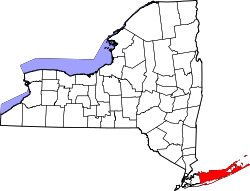Poospatuck Reservation, New York | |
|---|---|
 Map of Poospatuck Reservation | |
 Location of Poospatuck Reservation | |
| Coordinates: 40°47′23″N72°49′58″W / 40.78972°N 72.83278°W | |
| Country | United States |
| State | New York |
| County | Suffolk |
| Area | |
| • Land | 0.1130 sq mi (0.2927 km2) |
| • Water | 0.0562 sq mi (0.1456 km2) |
| Elevation | 17 ft (5 m) |
| Population (2020) | |
• Total | 436 |
| • Density | 3,858.4/sq mi (1,489.6/km2) |
| Time zone | UTC-5 (Eastern (EST)) |
| • Summer (DST) | UTC-4 (EDT) |
| ZIP code | 11950 |
| Area codes | 631, 934 |
| GNIS feature ID | 979384 |
The Poospatuck Reservation is a Native American reservation of the Unkechaugi band in the community of Mastic, Suffolk County, New York, United States. It is one of two Native American reservations in Suffolk County, the other being the Shinnecock Reservation. The population was 436 at the 2020 census.[ citation needed ]
Contents
The Unkechaugi are descendants of the Quiripi-speaking Native Americans, who occupied much of southern New England and central Long Island at the time of European encounter in the colonial era. Historically they spoke an Algonquian language. Many Unkechaugi have intermarried with African Americans. [1] They have retained a community; the reservation is the smallest in New York State. The current 55 acre reservation was originally set aside for the Unkechaugs as a 175-acre plot by William "Tangier" Smith after he purchased large tracts of land from Unkechaug John Mayhew in 1691. [2] It is located in Mastic on the north side of Poospatuck Creek, on the east side of Poospatuck Lane, and south of Eleanor Avenue. Poospatuck is situated in the southeast corner of Suffolk County's present-day Town of Brookhaven; and is the township's sole Indian reservation. On account of the innumerable tobacco shops, the reservation is known synecdochally as "Mastic Boges" by those in neighboring towns. It is about 70 miles or 1½ hours east of New York City.[ citation needed ]
The reservation and its people are recognized as Native American by the state of New York but it has not received federal recognition from the US Bureau of Indian Affairs. However, the Unkechaug established that it met the criteria of a Tribe as set out in the Supreme Court case Montoya v. United States, 180 U.S. 261, 266 (1901). The Unkechaug proved beyond a preponderance of the evidence that they met the criteria of a common law definition of a tribe consisting of the following:
- A body of Indians of the same or similar race;
- United in a community under one leadership or government;
- Inhabiting a particular though sometimes ill-defined territory.
In a 2009 case, federal District Judge Kiyo Matsumoto held that the Unkechaug satisfied all 3 Montoya criteria thereby entitling the Unkechaug to Sovereign Immunity from lawsuits because they are a federal Tribe under federal common law. [3]
